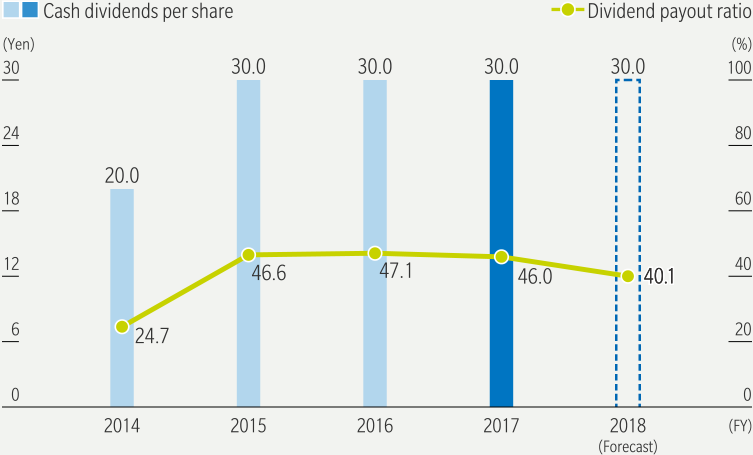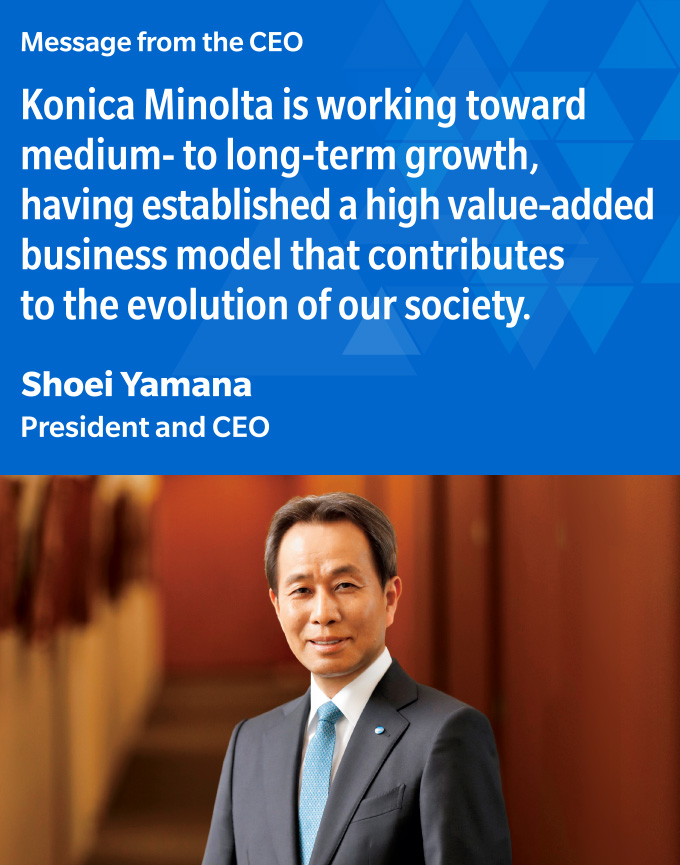Review of business results in fiscal 2017 Higher profit on higher revenue across all business segments
Fiscal 2017 marked the first year under our Medium Term Business Plan called SHINKA 2019. The Konica Minolta Group's business results for this important year featured higher profit on higher revenue, including consolidated revenue of ¥131.2 billion, up 7.1% year on year, and operating profit of ¥53.8 billion, up 7.4%.
Higher profit on higher revenue held true not only for the entire company but also for each business segment as well. This marks a very positive start as the initial fiscal year of our Medium Term Business Plan. I believe this is proof that the market has a positive take on our hybrid sales, which combines MFPs and IT Services, and high-valued added proposals that address the management issues of customer companies, carried out under the previous Medium Term Business Plan TRANSFORM 2016.
In our mainstay Office Business, both the installed base of digital MFPs and print volume have increased in a number of regions including North America, Europe, China and India. Looking at the market overall, sales of monochrome MFPs are declining, but we have actually increased sales of our own monochrome MFPs. In other words, customers are not simply looking to replace a monochrome unit with a color one. This is because we are providing document services along with IT solutions for improving customers' business workflow. This means that Konica Minolta is able to propose high-value added services that result in business reform based on a deep understanding of our customers in various industries and sectors. To make this a reality, we have been an active player in M&A and hiring globally for over five years now in order to acquire talent and expertise. The results of these "preparations" are now materializing in the larger installed base and print volume.
In the Professional Print Business, both the installed base and print volume of color digital printing systems are increasing. At the start of the shift from analog (offset) to digital printing, Konica Minolta was among the first to transition to digital printing and also develop a new market on its own called "light production printing." We automated print position adjusting and color adjusting, which once required the skills of craftsmen, using our knowledge in the print industry honed over the years through plate-making film for analog printing. I believe the strong performance of this business represents the outcome of our persistent efforts to solve our customers' key issues.
In our Healthcare Business, we saw growth in digital radiography (DR), which has seen strong results over the past few years, and we increased market share in the diagnostic ultrasound systems field, too. Our diagnostic ultrasound systems enjoy a dominant market share mainly in orthopedics in Japan, and we are now working to expand this to anesthesiology and obstetrics. Additionally, one of our preparations for expanding overseas business was the acquisition of Viztek (United States) in 2015. Viztek is a one-stop provider of proprietary hardware and software for medical imaging diagnostics along with medical IT solution services. It has deep connections with hospitals and clinics across the United States through its powerful sales network. The synergies produced between Viztek and Konica Minolta will enable us to deliver high value-added medical IT solutions that combine DR, diagnostic ultrasound, and picture archiving and communication systems (PACS). These synergistic effects have begun to materialize since the second half of fiscal 2017 and we anticipate even greater results in fiscal 2018.
Of particular note was the strong growth seen in our Industrial Business during fiscal 2017 underpinned by the trend toward larger LCD televisions and the growing smartphone market. In the performance materials unit, our mainstay product is TAC films used to protect LCD polarizers. During the year under review, sales of high value-added products such as VA-TAC film and ZeroTAC film for IPS enjoyed strong growth. We can expect the use of these films to expand to applications beyond televisions, including smartphones and tablet devices. In the measurement instruments unit, we greatly increased sales of measurement systems used in the inspection of Organic Light Emitting Diode (OLED) and other applications. OLED is expected to be widely adopted in applications and products outside of smartphones in the future. For this reason, we expect to see even greater growth in fiscal 2018 and beyond.
Fiscal 2018 marks the half-way point of the SHINKA 2019 Medium Term Business Plan. We will continue with our efforts to boost the profitability of our core business and increase profits in growth business. At the same time, we will carry out efficient investments aimed at developing new business over the medium to long term.
The business performance forecast for fiscal 2018 indicates another year of higher profits on higher revenues, with revenue expected to total ¥180 billion, operating profit ¥62 billion, and profit attributable to owners of the company ¥38.5 billion. Our forex assumptions are ¥105 against the US dollar and ¥125 against the euro.
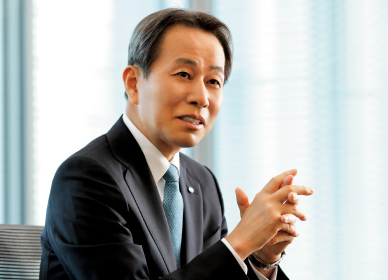
Outcomes of M&A strategy M&A for enhancing customer value
Since the merger of Konica and Minolta in 2003, we have discussed extensively the fundamental meaning behind the "shift from analog to digital." Through this, we discovered that digitalization is not always a positive for the manufacturing industry. We were among the first to recognize that failure to transform amidst the huge wave of digitalization would threaten our very existence in the manufacturing industry.
The key is to carefully probe the new value that digitalization can create for customers. From the perspective of the manufacturing industry, this means we have to answer the question "What type of new value can we propose to customers with digitalization?"
The impossible in an analog world becomes possible in a digital world. One such new customer value is on-demand printing in the Professional Print Business. Digitalization drastically transforms the conventional business model of mass production for mass consumption. This is because digitalization results in ultimate customization whereby the right item is made in the right quantity at the right place. In addition, digitalization contributes to environmental conservation and sustainability because product transport, a cause of CO2 emissions, and waste resulting from excess printed material are no longer part of the equation. Even in the Office Business, we can understand the flow of information and content in a customer's company as a business process and then automate and optimize this process, making it possible to solve many business issues faced by customers, including improving productivity and strengthening security.
However, to create such new customer value using digitalization, we had to acquire new technologies, expertise and talent from outside the company over a short period of time. As a result, we have added close to 40 IT service companies to the Konica Minolta Group from North America, Europe and Asia using an aggressive approach to M&A.
To achieve hybrid sales offered to customers as new solutions combining our technologies and expertise from document printing together with the IT capabilities of the companies we acquired, we have prudently considered various factors during M&A, including cohesion with local markets and affinity with our businesses. Based on this, we have carefully selected companies to the join the group that can generate synergies. After each acquisition, we combined employees from our business divisions with those of the acquired company at an early stage and reorganized them according to teams based on customer industries by sector. This enabled us to foster a sense of solidarity between both sides during the process of promoting hybrid sales.
This M&A strategy in the Office Business helped us to strengthen our proposal capabilities for our main middle-market and small- and medium-sized enterprise customers. Not only that, we have also been able to boost our capabilities to respond to the needs of major global companies. As a result, we have seen steady growth over the past four or five years, for example, in the business of providing integrated printing system services to various global companies.
In fiscal 2017, we executed major M&A deals in the Healthcare Business, too, enabling us to make a full-fledged entry into the domain of precision medicine. In the Healthcare Business, we have held comprehensive discussions on the future of the business for several years now. The focal point of these discussions involved the potential of High Sensitive Tissue Testing (HSTT) developed using our technological know-how from photographic films. HSST quantifies cancer cells and other specific proteins with high precision. For this reason, it has received strong praise from various parties including overseas academic societies.
With HSTT as the core, we have established the precision medicine business capable of accurately and efficiently diagnosing cancer at an early stage and for effectively developing therapeutic drugs and contributing to drug administration. One aspect behind the commercialization of HSTT required genetic analysis technologies. No other company in the world is capable of analyzing both proteins and genes, two elements indispensable to precision medicine, and so we decided to move in this direction. Another area where we needed to bolster was our connection with pharmaceutical companies. As a result, we searched for companies already involved in new drug discovery support systems and companies using cutting edge AI in new drug discovery and development.
The two major M&A deals we struck in the precision medicine business in fiscal 2017 were intended to acquire these two elements. One of these companies is Ambry Genetics Corporation (AG), a genetic diagnostic services company. Combining AG's genetic diagnostic technologies with our HSTT technology enables even more precise patient classification, improving the success rate of new drug discovery and development and contributing to more effective drug administration. The other company is Invicro, which provides new drug discovery support services. Invicro has been contracted by a number of pharmaceutical companies for its very important services for discovering biomarkers using imaging in the pre-clinical trial stage, the most upstream part of new drug discovery. Combining Invicro's functions with our HSTT and AG's genetic diagnostics will make it possible to support new drug discovery and development for such diseases as cancer and Alzheimer's. This precision medicine business represents an initiative aim at resolving a social issue, and I believe it will be an extremely important part of our efforts to enhance corporate value over the medium to long term.
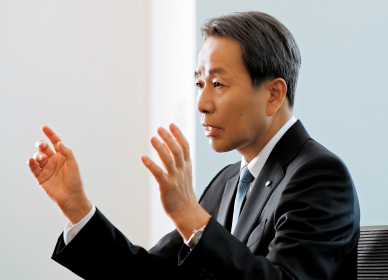
Medium- to long-term growth strategy Aiming to become a high-profit enterprise using a new business model powered by data
Our world is undergoing significant changes brought about by the remarkable progress of information and digital technologies. We find ourselves in the middle of a paradigm shift that will fundamentally transform the conventional wisdom of various domains.
As I have repeated many times before, I believe these turbulent times represent a major opportunity for Konica Minolta. In each of our various business domains, we will be able to present our own take on new value and approaches to the world around us. This means we will stand at the forefront of change instead of simply adapting to it. This is precisely why I feel turbulent times represent an opportunity.
The SHINKA 2019 Medium Term Business Plan cites becoming a digital company with insight into implicit challenges as Konica Minolta's future goal. To achieve this goal, we need to build a new business framework that is both customer-centric and people-centric, while continually refining our strengths developed as a manufacturer, including capabilities in manufacturing, engineering and development.
As a manufacturer, Konica Minolta possesses capabilities in high quality manufacturing and hardware development. In addition, through the previous Medium Term Business Plan, we meticulously prepared ourselves to deliver IT solutions. Through business development combining these areas, we will be able to accumulate valuable data on various domains, and then analyze and visualize this using such cutting edge technologies as AI and deep learning. This should position us to establish a novel business model and create completely new forms of customer value. Our plan is to carefully set up a high-valued added platform business suited to this era of IoT over the next several years.
This new platform is Workplace Hub (WPH), which we plan on releasing in fiscal 2018. As I mentioned earlier, Konica Minolta has boosted the added value it offers by providing hybrid forms of document and IT service solutions that delve into the business operations of customers from a multitude of different industries and businesses. Going forward, we will develop the solutions business with the platform of WPH as the focal point. By installing this WPH in the same space as one of our digital MFPs, not only will customers be able to use IT services in a one-stop fashion, but WPH will be able to accumulate data useful to improving the business operations of various industries and sectors.
For example, in the case of the manufacturing industry, data can be used to visualize the utilization rate of production facilities to increase efficiency, improve quality and reduce loss. Or, data for work-style reform will make it possible for efficient remote work in a secure environment in terms of information security. Even in the field of nursing care, data from WPH can be warehoused and analyzed to create completely new forms of customer value, such as approaches to facility spaces for better care support or the optimization of nurse movements and room layouts.
This is not the same as a major IT services company analyzing vast amounts of big data on the cloud. Konica Minolta's strength is our direct connections with some two million customers around the world through our digital MFP business. We are aiming to realize new value together with customers on the edge of business for a multitude of different sectors. Moreover, every single piece of data collected from WPH does not need to be brought to the cloud. Data and images gathered from the frontlines of business can simply and instantaneously be analyzed and processed on the spot to come up with ways of improving each business process. Nobody could keep pace even if every single piece of data was brought to the cloud and created a huge data center was created. In the sense of achieving a sustainable society, I believe we are taking the right direction with finding solutions to issues on the edge.
The accumulation and analysis of digital data also holds the key to precision medicine, our other medium- to long-term strategic area. In January 2018, we established a global headquarters in the United States for the precision medicine business and set up a business operation system. As Konica Minolta, AG and Invicro work as one entity, I am convinced that we can establish diagnostic services that will usher in dramatic progress in the fields of cancer treatment and new drug discovery support. Combining the talent from the specialty fields of these three companies along with the scale merits of synergistic effects will help us to turn our attention toward business expansion not only in the United States and Japan but also Europe. Our goal for fiscal 2021, four years from now, is for this business to generate revenue of ¥100 billion and operating profit ratio of 20% or greater. By establishing a presence at the top of the global precision medicine field, we hope to become a leader that can influence the operational systems of medical institutions around the world.
Through these initiatives, Konica Minolta is aiming to achieve the business targets of more than ¥75 billion in operating profit, ¥50 billion in profit attributable to owners of the company, and ROE of 9.5% by fiscal 2019, the final year of the Medium Term Business Plan. Beyond this, we are looking to achieve a medium-term target of more than ¥100 billion in operating profit and more than ¥70 billion in profit attributable to owners of the company by fiscal 2021.
Increase added-value using digitalization and reinforce customer relationships
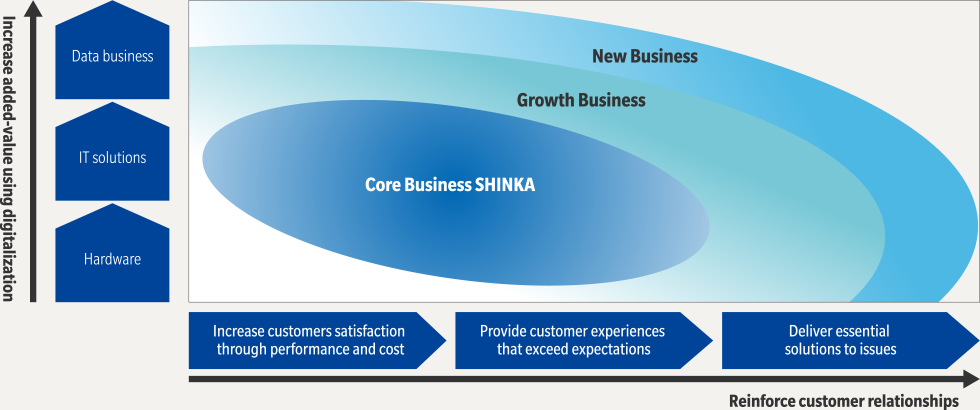
Enhancing long-term corporate value Aiming to be a leader in ESG
Under Our Philosophy, “The Creation of New Value,” Konica Minolta has prospered together with society while pursuing new value essential to each specific time period of its history. In recent years, as social issues such as environmental problems, aging society, and personnel shortages emerge, expectations are rapidly rising when it comes to companies’ initiatives for sustainability. This is especially true following the adoption of the Sustainable Development Goals (SDGs) by the UN and growing interest in Environment, Social, Governance (ESG) investments in financial markets. I believe the growth of a company should be connected to solutions to social issues. Without a solid balance of enhancing economic value and social value, I believe a company will not be able to achieve sustainable growth or enhance corporate value over the medium to long term. In this sense, I consider the embodiment of business strategy as the reinforcement of ESG. Looking out 10 and 20 years into the future, our business strategy to contribute to solutions to various social issues represents an ESG initiative.
The strategies being implemented by each of our business divisions contribute to an evolution, or SHINKA, in society. These strategies include dramatically increasing office productivity, achieving work styles that empower creation, and improving the quality of life for patients around the world. This is the reason why the word SHINKA was used in the title of the Medium Term Business Plan.
Not only technology, but the power of our people will be vital in finding solutions to social issues. Our approximately 43,000 employees will become a powerful driving force by doing the right thing for society and for customers. Therefore, we must transform our organizations into places where talent with varying experiences and backgrounds can interact as well as respect and motivate each another to create new ideas. My role as CEO is to foster this type of culture and draw out the capabilities of our workforce.
With regards to corporate governance, while passive governance such as internal control is necessary, I hope to evolve this into active governance because it supports a company in its efforts to tackle social issues while taking risks.
Furthermore, to carry out management with a more medium- to long-term perspective, we revised our officer compensation system in fiscal 2017 and introduced stock bonus linking with medium-term performance. In conjunction with this, we incorporated ESG and other non-financial indicators into the performance evaluations of executive officers, and we introduced a system of monitoring by the Board of Directors.
Looking ahead, instead of taking a passive approach to avoiding risks in terms of ESG, we will take active measures with the goal of becoming a world leader in ESG, aspiring to become a global company that is vital to society.
Shareholder returns Committed to continually increasing our dividend
Konica Minolta is committed to aggressive growth investments for sustainable growth and to actively returning profits to shareholders using the profits and cash we generate. Our basic stance on dividends places a greater emphasis on absolute value.
We want investors that support our growth from a medium- to long-term perspective to own our stock. Consequently, our goal is to meet shareholder expectations by continually increasing our dividend, instead of adjusting it upward or downward based on short-term changes in business performance. Furthermore, in addition to dividends, we are carrying out share buybacks as well.
Under this policy, we offered an annual cash dividend of ¥30 per share (same as previous year) for the fiscal year ended March 31, 2018. In addition, we plan to provide an annual dividend of ¥30 per share in the year fiscal ending March 31, 2019 as well.
Konica Minolta will continue to seek out sustainable growth while living up to the trust of its many stakeholders including shareholders. I kindly ask for your continued support and understanding as we move forward.
Cash dividends/dividend payout ratio
